A Gentle Beginner's Guide To Preserving Food
Should you be canning?
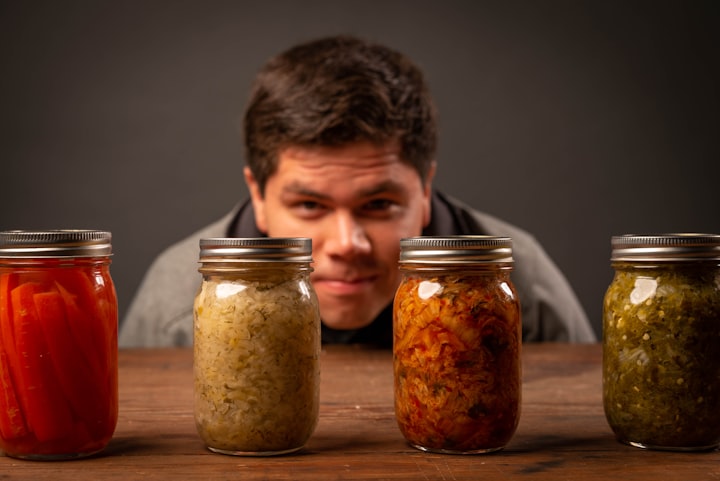
So, you’ve got pantry envy. Now what?
If the last two years have made you feel vulnerable, you’re not alone. It’s been a really hard shift from an immediate need-it-want-it-gotta-have-it-buy-it-now mindset to one that forces us to think about things like long-term food storage, or whether we’ll be able to buy flour when we want it.
It’s easy to look around the internet and find the hordes of people who’ve prided themselves on their preparation and preservation skills; the ones who have Pinterest-worthy pantries chock full of pickles and preserves.
There are youtube videos of homesteaders cranking out homemade sausage, parents making sourdough, and many, many people canning. If you want a tutorial on how to can food, it’s out there. This piece isn’t that.
This piece is about whether or not you should take up canning right now.
There’s a lot of different ways to store food; my goal is to break down the logistics of each so you can make an informed choice about what’s going to work best for YOU. We’ll be talking about stocking, freezing, fermenting, dehydrating, and canning.
Option 1: Stocking Up
Skill level: low
Equipment barrier: low
Financial barrier: high
Building a pantry by buying things has one of the lowest skill barriers, but highest financial barriers you can have. The approach here isn’t about making single giant shopping trips — that is a super-overwhelming way to go about it. Rather, use the structure of your regular shopping to build and expand on what you’ve got by acting as though you’re going to have each meal you’re shopping for twice, and doubling the pantry goods for those meals.
Example: your family loves tacos. You normally buy shelf-stable tortillas or taco shells, refried beans, ground beef, taco seasoning, sour cream, lettuce, shredded cheese and salsa. On a stock-up trip, you would buy two boxes of taco shells, two cans of refried beans, etc.
You would also buy two packages of ground beef and freeze one, if you can, and a large-enough tub of sour cream for two meals, since sour cream will last for months in the fridge. Get just enough lettuce for one meal; that’s a good example of a perishable thing that won’t work well for long-term storage. But now you’ve got two full taco meals, and you only need to procure one more fresh ingredient to make it work a second time (or just go without). Cool!
Okay, so that’s just one meal. But consider this: the ingredients for tacos are pretty close to ingredients for a good chili. By buying extra ingredients as though you’re planning for meals (as opposed to: I MUST BUY EIGHTY POUNDS OF FLOUR FOR…SOMETHING, I’M SURE) you’re going to build yourself a few shelves’ worth of stuff you actually use, which is going to help you feel a lot more safe and secure than buying up tons of bags of rice and beans.
Option 2: Freezing
Skill level: low
Equipment barrier: low
Financial barrier: low-high, depending on if you purchase a chest freezer

The nice thing about freezing is how many people have access to at least a little freezer space. Thus, the only upfront costs need be some good containers for freezing. Heavy-duty ziploc bags are an inexpensive, good start — a nice hack for those is to fill them halfway, lay flat on a counter and make sure the contents fill the bag from corner to corner; that way, you can freeze it flat, which takes up less room and makes less work for thawing.
Should you buy a chest freezer? Honestly, no. One power failure could destroy your food supply if you’re counting on a chest freezer. The exception to this is hunters, but if you hunt food, you already know that. If you’re a beginner at this, the most a chest freezer is going to do is tempt you to fill it, at which point you’ll never be able to find anything and get super overwhelmed. I don’t want that for you, you know?
Option 3: Fermenting
Skill level: moderate
Equipment barrier: low
Financial barrier: low-moderate
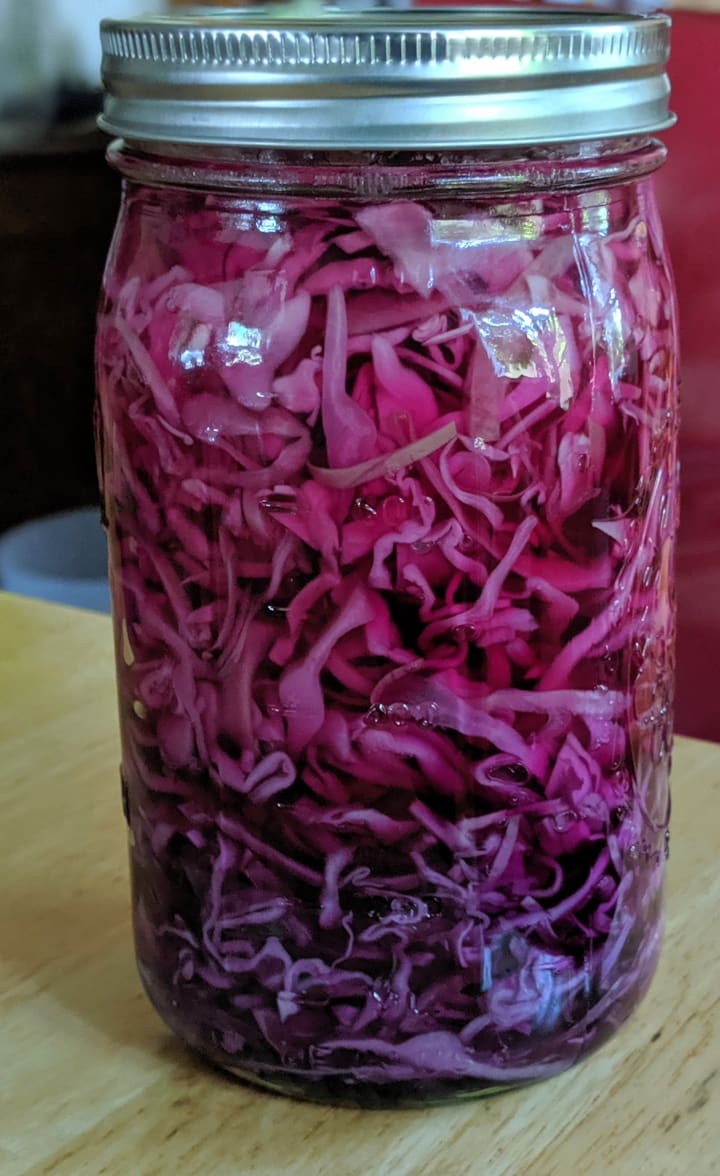
Fermenting’s biggest limits are twofold: there’s only so much fermented stuff you WANT to eat, and it has to be stored in cold places, which means you can run through fridge space FAST.
That said, the only thing you need to start fermenting is a head of cabbage (other veggies work, but cabbage is the classic starter veg — very forgiving, with easy success,) a bowl, a large-ish jar (a recycled pickle jar will do) and a pile of (not table) salt. That’s a pretty low barrier.
Fermenting is one of the few things on this list that also makes a great one-afternoon family activity, since the rest of process is “leave it on the counter until it’s done.”
Be prepared to screw up a few ferments. This is another reason cabbage is the perfect starter vegetable — it’s cheap enough that you won’t cry over an oversalted or rotted batch.
This means, of course, that you have to want to EAT the sauerkraut afterwards, which is going to be a barrier for some people. Others, like me, will be amazed at the kingdom to which they’ve just discovered the keys.
Option 4: Dehydrating
Skill level: low
Equipment barrier: moderate
Financial barrier: moderate-high up front (>$100), low going forward
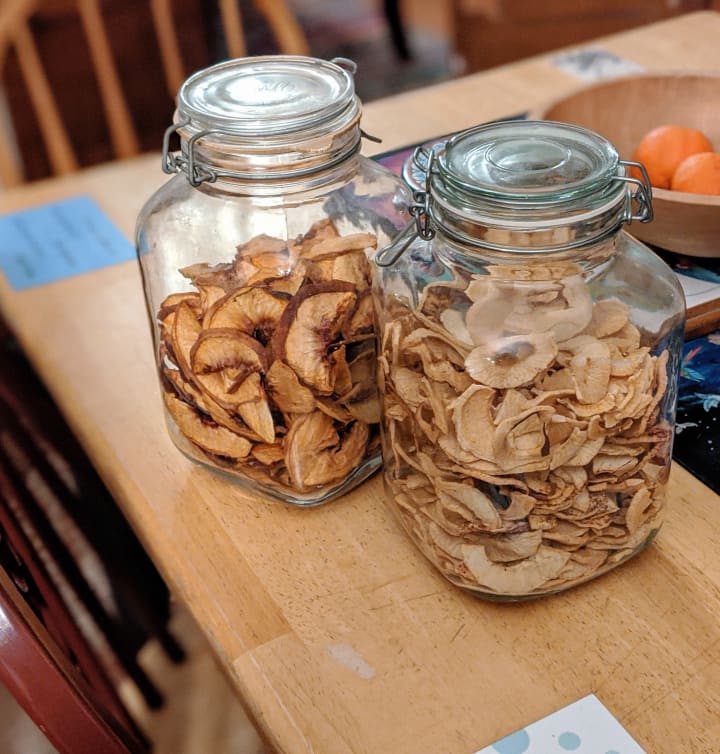
I’ll be honest: dehydrating was my first foray into the wild world of food preservation, so I’m biased, but it’s a really delightful way to get going — low effort, high reward.
Drying doesn’t work for everything; it makes terrific snack foods (dried fruit or meat/tofu jerky) and can make a passable soup mix. There are some great tutorials for making complete meals out there — try searching recipes for camping or backpacking — but most of my dehydrating life has been spent on snacks.
I’ll take the controversial road on equipment: you do not need a super-expensive dehydrator to get you started. Presto and Nesco are good reputable brands, and both have beginner dehydrators for under $60. Craigslist often has them, too — they’re a really common “we got this and never used it” appliance.
Dehydrating doesn’t take a lot of active time — just enough to slice whatever it is you’re drying, and lay it out on the racks, which makes it the perfect option for people who can only work in short bursts (looking at you, parents!) Very much a set-it-and-forget-it operation.
Option 5: Canning
Skill level: moderate-high
Equipment barrier: high
Financial barrier: high upfront, moderate going forward
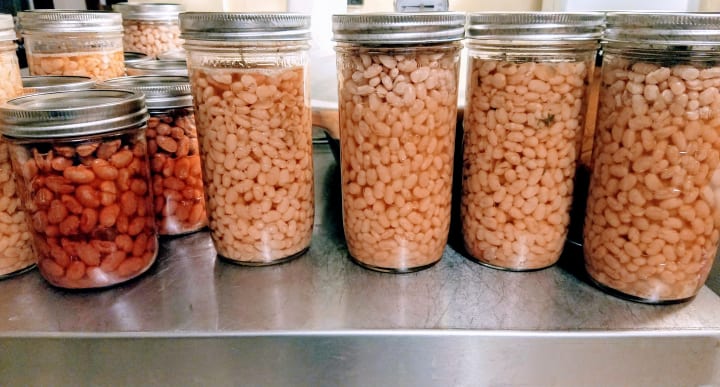
Canning, in some ways, feels like the gold standard of preservation, because it’s the one that leaves you with the most ready-to-eat options. After all, what’s more convenient than taking something off the shelf and opening it up? Canned food doesn’t spoil when the power goes out, doesn’t require cooking or rehydration — the true convenience food.
That said.
There are two levels of canning: beginner (water bath) and expert (pressure canning.) Water-bath canning is only good for two things: pickles and jams. (And the occasional tomato sauce.) If your family goes through pickles like hotcakes, then canning is well worth the investment for a whole winter’s worth of shelf-stable pickles. If you have berry bushes in your yard that produce more blackberries than you can eat in a summer, canning is a good skill to have (or just invite me over; I’ll take care of that pesky berry abundance for you.)
Things like canned beans, broth, soup and stew? Those are pressure-can-only kinds of deals. Pressure canning takes a lot more time and a lot more skill.
Jars cost a lot more than plastic bags. But they also last forever, being glass. One of the great up-sides to canning is the absolutely minimal waste it produces. But all great canners will tell you that it took YEARS to build up their canning practices, including their jars, their canning equipment, and lids. Trying to launch a full-scale canning practice in a week is a really good way to overwhelm, discourage, and burn yourself out.
The key with dehydrating and canning is this: they were designed to deal with a lopsided cycle of abundance and scarcity — the farming year, or the hunting season. They work best for people who can imitate that cycle, whether by growing or hunting their own food, buying in bulk when there’s good sales, or joining a CSA (community-supported agriculture, in which you pay up front for a share of a farm’s harvest, and get inundated with vegetables throughout the summer.)
If you live paycheck-to-paycheck, then the best way to go about these methods is, as many things, together. There’s no reason six families need six dehydrators, or six pressure canners. Pool your resources and pass it around. Divide the labor, too — the people who have extra money (this week) can purchase fruits or vegetables on sale and drop them off, and people who have extra time (this week) can be responsible for preparing, processing, and parceling out the goods.
So, with that said, if you’ve never before thought about planning for a present (and future) in which frequent trips to the grocery store aren’t prudent or possible, here’s one way you might get started building up a supply of food.
- Decide on your budget. You can do this with $20, or with $200 or $2,000. But knowing ahead of time how much you’re willing to spend on this experiment (and it IS an experiment — with all the success and failure that goes with experiments. You may end up throwing away some food!) will help you manage your stress levels when you end up with a bad batch of jam.
- Figure out your time commitment. Don’t stick yourself with the burden of learning a whole new set of skills when you’ve got eight full-time jobs (plus the one you actually get paid for…)
- Say ahead of time: This is an experiment. Failure is necessary. Success is earned through practice and experience. Set your expectations to Reasonable Learning Standards.
- EAT WHAT YOU MAKE! I can’t stress enough how many of my first preservation attempts sat on the shelves for WHOLE YEARS because I couldn’t bring myself to actually consume the stuff once I’d worked so hard to make it. The truth is, I still have a little of that habit now.
- Don’t preserve food you hate. This is actually a memo to myself, since I’m still staring at that green tomato chutney and sighing. Yeah, I needed something to do with all those green tomatoes at the end of last summer, but MAN, I am not a chutney person, overall. 6 pints was way overkill.
- Enjoy the process. Enjoy the satisfaction that comes with thinking ahead and planning. Enjoy the feeling of security that comes with food on the shelves. Enjoy the creativity it brings out. Enjoy.
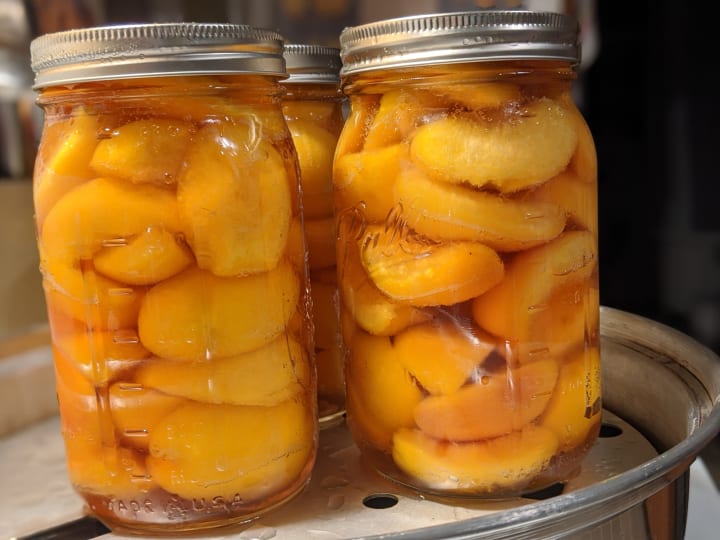
About the Creator
Dane BH
By day, I'm a cog in the nonprofit machine, and poet. By night, I'm a creature of the internet. My soul is a grumpy cat who'd rather be sleeping.
Top Story count: 17
Check out my Vocal Spotlight and my Vocal Podcast!
Reader insights
Outstanding
Excellent work. Looking forward to reading more!
Top insights
Easy to read and follow
Well-structured & engaging content
Compelling and original writing
Creative use of language & vocab




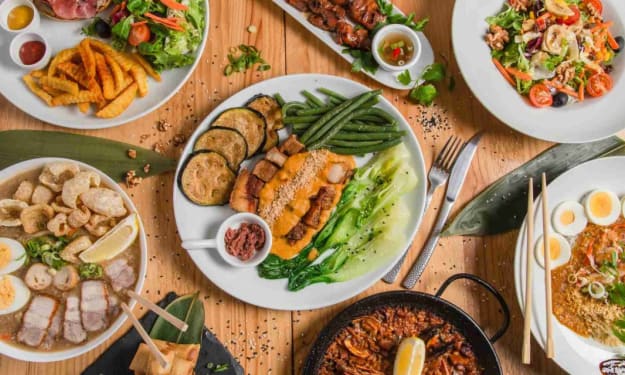


Comments
There are no comments for this story
Be the first to respond and start the conversation.